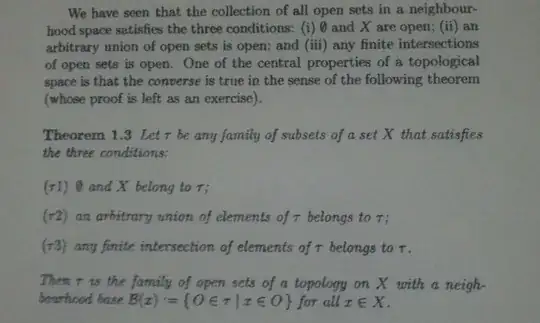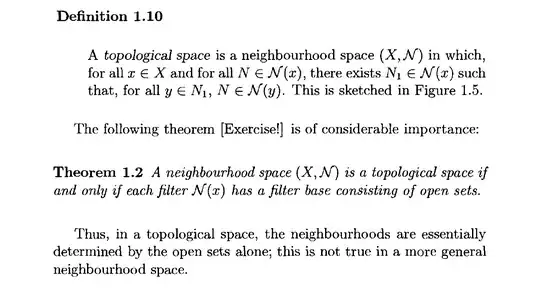There are several things to prove. So assume $\tau$, a family of subsets of $X$, satisfies the three axioms. Then we define for every $x \in X$: $\mathcal{B}(x) = \{ O \in \tau: x \in O \}$. Claim 1: this is a neighbourhood space, with neighbourhood filters generated by $\mathcal{B}(x)$.
As $X \in \mathcal{B}(x)$ for all $x$ (as $X$ is in $\tau$), all sets $\mathcal{B}(x)$ are non-empty. Also, by definition, all members of $\mathcal{B}(x)$ contain $x$. When $O_1, O_2 \in \mathcal{B}(x)$, then $x \in O_1 \cap O_2$, and $O_1, O_2 \in \tau$, so $O_1 \cap O_2 \in \mathcal{B}(x)$, so that the sets $\mathcal{B}(x)$ indeed form a filter base at each point. So $\mathcal{N}(x) = \{N: \exists O \in \mathcal{B}(x): O \subset N \}$ is the neighbourhood filter at $x$.
We then define open sets as always: $O \subset X$ is open, iff for all $x \in O$, $O \in \mathcal{N}(x)$ ($O$ is a neighbourhood of each of its points), so (as the $\mathcal{B}(x)$ form a filter base) for all $x \in O$, $\exists O_x \in \tau$ such that $O_x \subset O$. But then $O = \cup \{O_x: x \in O \}$, for these $O_x$ (as each $x \in O$ is in its "own" $O_x$, so $O$ is a subset of the union, while all $O_x \subset O$, so the other inclusion also holds). But all $O_x$ are in $\tau$ so $O \in \tau$ by the third axiom. So $O$ open in the neighbourhood space implies $O \in \tau$. But also, if $O \in \tau$, for every $x \in O$, $O \in \mathcal{B}(x)$ by definition, so indeed $O$ is a neighbourhood of each of its points and $O$ is open in the neighbourhood space. So $\tau$ is exactly the collection of open sets of the neighbourhood space definded by the filter bases $\mathcal{B}(x)$.
This proves the theorem 1.3 from your book.

